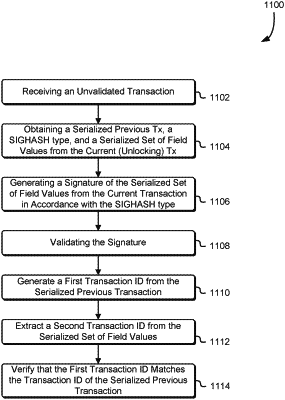| CPC G06Q 20/389 (2013.01) [G06F 16/2379 (2019.01); G06F 21/6209 (2013.01); G06F 21/645 (2013.01); G06Q 20/065 (2013.01); G06Q 20/0658 (2013.01); G06Q 20/36 (2013.01); G06Q 20/3674 (2013.01); G06Q 20/3825 (2013.01); G06Q 20/3829 (2013.01); H04L 9/0637 (2013.01); H04L 9/0643 (2013.01); H04L 9/30 (2013.01); H04L 9/3236 (2013.01); H04L 9/3239 (2013.01); H04L 9/3247 (2013.01); G06Q 10/10 (2013.01); G06Q 2220/00 (2013.01); H04L 9/3066 (2013.01); H04L 9/3252 (2013.01); H04L 9/50 (2022.05); H04L 2209/56 (2013.01)] | 14 Claims |

|
1. A method comprising:
receiving, at a node in a blockchain network, a first transaction to validate, the first transaction including a first script and a second script;
executing the first script followed by the second script to obtain a serialized second transaction, a signature hash type, and a serialized set of unlocking transaction fields;
generating a signature based at least in part on a serialized set of field values of the first transaction and the signature hash type;
validating the generated signature;
generating a first transaction ID based at least in part on the obtained serialized second transaction;
extracting a second transaction ID from the serialized set of field values of the first transaction; and
determining whether the first transaction ID matches the second transaction ID.
|